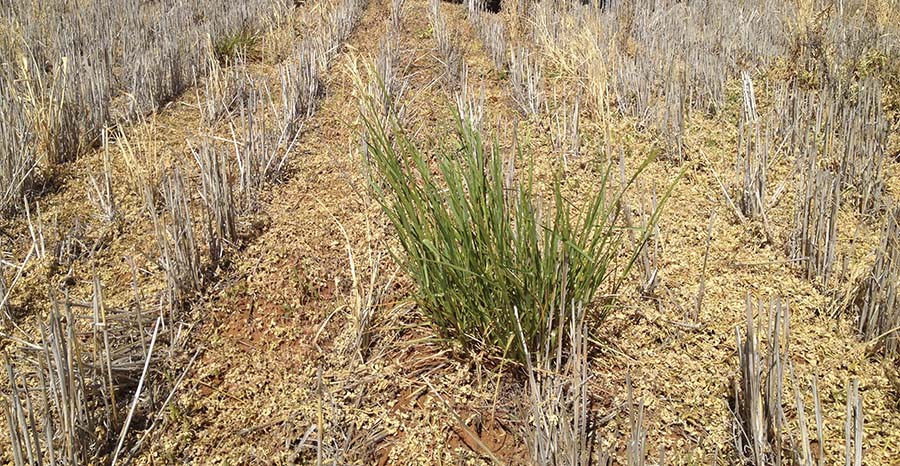Weed Management Initiative
Weed Management Initiative
GRDC’s national Weed Management Initiative (WMI)
The Weed Management Initiative is a $47 million investment led by GRDC and developed to support Australian grain growers to manage one of the most persistent and costly challenges facing farming businesses.
WMI aims to provide sustainable and effective weed management strategies through four nodes across Australia, ensuring both national collaboration and regional specificity.
The 5.5-year initiative will bring Australia’s leading researchers and communications and extension specialists together to work on innovative, cutting-edge weed management research, development and extension (RD&E).
Conservatively, weeds impose an annual cost on growers of approximately $4.1 billion in lost production and control measures. This equates to around $196 per hectare.
This financial burden is exacerbated by the rapid evolution of herbicide-resistant weeds, limited availability of new chemical control options, and shifting climatic conditions affecting weed distribution and frequency.
WMI was a critical investment that GRDC was making on behalf of Australian grain growers and built on three decades of weed RD&E.
Key elements
- GRDC has invested $25M on behalf of Australian grain growers into the WMI, matched by $22M in co-contribution from our strategic partners.
- The WMI will support more than 20 weed research scientists, working under experienced node leads, as well as 12 new PhD student scholarships to build critical capacity in this field.
- Investment in innovative, cutting-edge, integrated weed RD&E is crucial for the sustainability and profitability of Australian grain growers.
- Four regional nodes will be established: one in WA, one in the southern region (South Australia, Tasmania and Victoria) based within the University of Adelaide, two in the northern region (Queensland and New South Wales) – catering for the summer and winter cropping systems.
- This initiative will help reduce the economic impact of weeds on our farming systems and foster a collaborative research environment capable of responding swiftly to emerging challenges.
Partners
Under this initiative:
- GRDC has invested $25M to create regional nodes with strategic partnerships and $22M in co-contributions from The University of Western Australia, The University of Adelaide, Charles Sturt University and The University of Queensland.
- The federated approach would build on GRDC’s long-term investment in integrated weed management and foster a collaborative, well-resourced and interconnected research community, and ensure cohesion in national efforts across RD&E.
Programs of work
Five programs will be delivered through the WMI that span the continuum of herbicide resistance from evolutionary dynamics to on the ground mitigation strategies, communications and extension along with capacity building and succession planning.
The five programs are:
- Program 1. Evolutionary dynamics of weed adaptation and herbicide resistance.
- Program 2. Biochemical, molecular and genetic basis of novel herbicide resistance.
- Program 3. Mitigation and management of weeds using novel and integrated approaches.
- Program 4. Capacity, expertise and collaborative uplift.
- Program 5. Communication, extension and adoption of weed research outputs.

Why this new approach to weed management research, development and extension?
GRDC is committed to ensuring Australian growers have the research, resources and information they need to inform weed management practices on-farm.
GRDC is accountable to Australian grain growers and needs to manage RD&E investments in a prudent and responsible way and regularly assess investments from a return-on-investment perspective.
As part of active management GRDC regularly commissions independent reviews to determine the effectiveness and value of current and new RD&E investments
The GRDC is transitioning to the WMI in 2025, which will enhance leadership in weed resistance management across Australia.
This new initiative stems from an independent review commissioned by GRDC in 2023 into WeedSmart and the Australian Herbicide Resistance Initiative (AHRI).
The review recommended a more national, collaborative approach to weed management research and highlighted the importance of incorporating social science into communication and extension strategies to better support grower adoption.
GRDC values the contribution made by WeedSmart and AHRI in terms of providing growers and agronomists with research outcomes and key information about on-farm weed management.
How will this impact AHRI?
The AHRI personnel at UWA will continue to operate as the western node of the WMI, which will have significantly more GRDC investment to continue weed management research and development in WA and nationally.
How will this impact WeedSmart?
GRDC regularly assesses the return on investment (ROI) of all RD&E projects as part of being a prudent, active and responsible investor and this assessment extends to new and established projects. As part of active management GRDC also commissions independent reviews to determine the effectiveness and value of RD&E investments.
Since its inception in 2013, GRDC has invested more than $2.5m in WeedSmart. Our annual contribution of $350,000 accounts for 43 per cent of WeedSmart’s current sponsorship. GRDC has made the decision to continue to invest and manage the WeedSmart program through 2024/25.
This will ensure that the WeedSmart program can continue as a dedicated communication and extension platform to deliver core weed management strategies, such as the 'Big 6'. WeedSmart will maintain its strong focus on peer-to-peer learning, trusted brand recognition, and innovative media platforms, including WeedSmart Week.
WeedSmart can also continue to align its work with sponsor priorities and industry needs, including addressing broader weed management issues.GRDC will review investment in the WeedSmart project based on best value for Australian grain growers in 2025/26.
